Day 11 Monday Dec 4, 2023
Farida apt checkout at 6am, Bag drop at Mama Africa apt 1 km away, Abydos Dendera, Mama Africa apt checkin [we had added 1 more night at Luxor later and could not continue on at Farida apt, hence the move]

CHECKOUT FROM FARIDA APARTMENT
We packed our bags and checked out by 5.45 am. Took pics as usual
Key left on the table as instructed
Hamdi helped carry our bags down the 3 flights of stairs, we drove to MAMA AFRICA, Deposited our bags and went on toward Dendera
LOVELY SUNRISE
Dendera Temple complex: Temple of Hathor
Dendera Temple complex is located about 65 kilometres north of luxor, Egypt. It is one of the best-preserved temple complexes in Egypt.
the first building on the site went up around 2250 BCE, but the standing structures mostly date from the Ptolemaic era. in 54 BCE, when construction began on the Temple of Hathor, the most prominent structure at the Dendera complex.
The Temple of Hathor was built primarily during the Ptolemaic Dynasty, which was a period of Greek rule in Egypt.
However, construction of the temple was completed under the Roman emperor Trajan, who is seen depicted on the walls of the complex making offerings to Hathor.
The temple complex also includes a monumental gateway, constructed by Trajan as well as Domitian, another Roman emperor... seen below
Entrance gate to the temple, with sphinx and bas-relief [Pharoah offering to Hathor and Ra Horakty]
First Courtyard
HATHOR TEMPLE
This temple was dedicated to the goddess Hathor, who was worshipped as the goddess of love, fertility and music.
This site was a center of the cult of Hathor. During a period known as
the Happy Reunion, Hathor would journey from her temple at Dendera to spend some time with her husband, Horus, at his temple in Edfu.
This “reunion” was a yearly occurrence, and at the end of the celebration, the return of Hathor to Dendera was thought to signal the official beginning of the flood season of the Nile.
Large Hypostyle Hall/the Great Vestibule
It is the front room at the main entrance fronted by 24 columns. The ceiling in the Great Vestibule is a tribute to Nut (Newt), Goddess of the Sky.
Beyond are antechambers with crypts, chapel rooms, and a sanctuary. There is a corridor on each side of the second antechamber. The corridor to climb to the top of the temple is a spiral, just as a bird would ascend, while the corridor to leave the roof is a straight path down, just as a bird would dive. This is a tribute to Horus.
Small Hypostyle Hall
Columns have the face of Hathor with the cow ears
AWESOME Raised RELIEF WORK...
Roman Emperor Trajan brings offerings to Hathor and Ra-Harakhte
The guardian took off the rope and told us to climb up the ladder and see the room above
Roman Emperor Trajan brings offerings to Hathor and Ra-Harakhte

CORRIDORS WITH STEPS LEADING TO THE ROOF
Chapel of Osiris
below is an antechamber, called the Chapel of Osiris. there are scenes of the resurrection of Osiris and Isis conceiving Horus
Inside this chapel, one of the rooms holds a unique ceiling relief, called the Dendera Zodiac. It is considered the only complete “map” of the ancient Egyptian sky. The one at Hathor Temple is a replica, however. The real Dendera Zodiac is on display at the Louvre in Paris
HORUS BEING CONCEIVED
Isis as falcon hovering over Osiris body, conceiving Horus


Zodiac of Dendera
The temple originally housed the famous Zodiac of Dendera. This bas-relief with human and animal figures represented a night skyscape, and was found on the ceiling of a chapel in the Temple of Hathor, where the mysteries of the resurrection of the god Osiris were celebrated. Egyptologists determined it should be interpreted as a map of the sky rather than a giant horoscope or a perpetual astrological tool.
The particular configuration of the planets among the constellations shown in the Zodiac of Dendera occurs only about once every thousand years. Two astrophysicists have dated it to between June 15 and August 15, 50 BCE. Two eclipses are represented on the Zodiac exactly where they occurred at that time.
The representations of the signs of the zodiac as we know them today did not appear in Egypt until the Greco-Roman Period. This monument reflects the way Egyptian cultural elements merged with Babylonian and Greek astronomical and astrological theories, as a result of the Assyrian and Babylonian deportations of the eighth and sixth centuries BCE, and the Persian and Greek invasions of the sixth and fourth centuries BCE.
The Zodiac of Dendera was transported to France in 1821, with the permission of Mohamed Ali Pasha, who was the Turkish viceroy of Egypt at the time. The Egyptian government has asked for its return. It currently is on display at the Louvre in Paris.
Kiosk of Hathor on the temple roof... small temple that was used for rituals to greet the rising sun,
outside walls...
Note the Pharoah's robe which has battle scene and the sheer excellence of the raised relief work...
ISIS NURSING HORUS
we walked back to the car and were driven onward to Abydos
Report continues here:








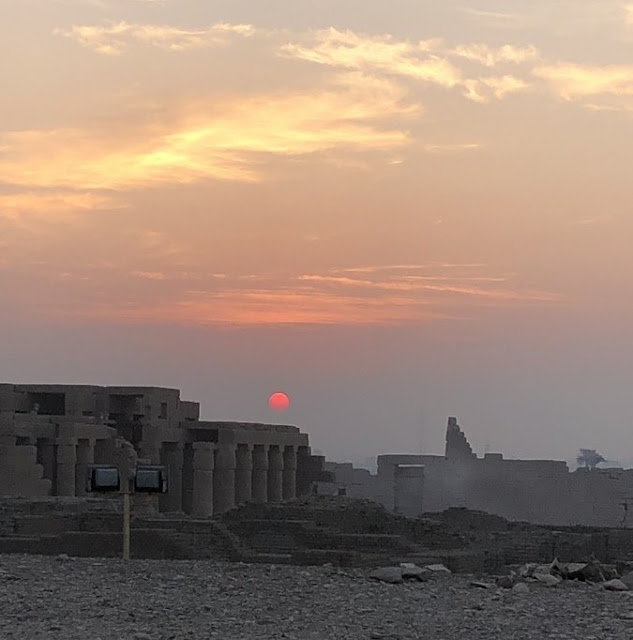







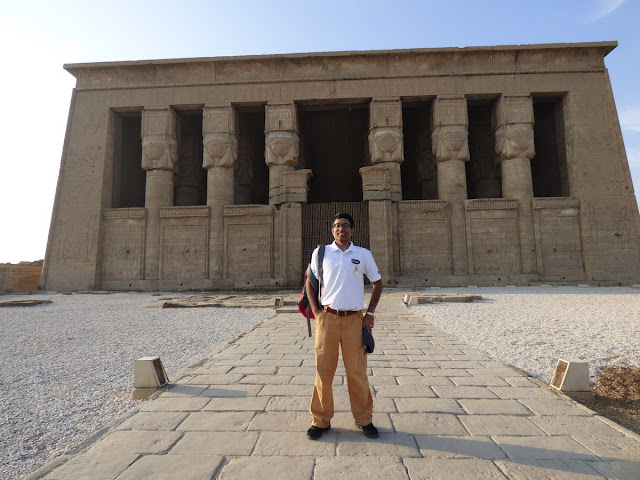


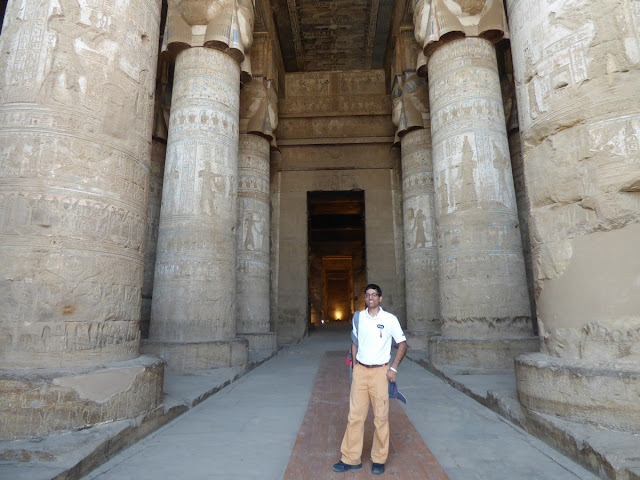

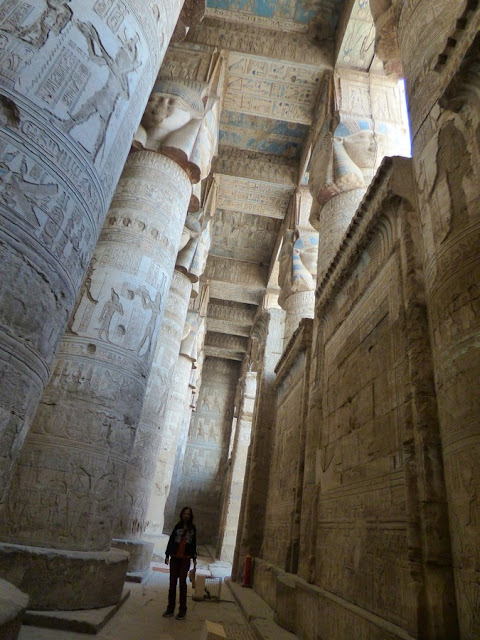







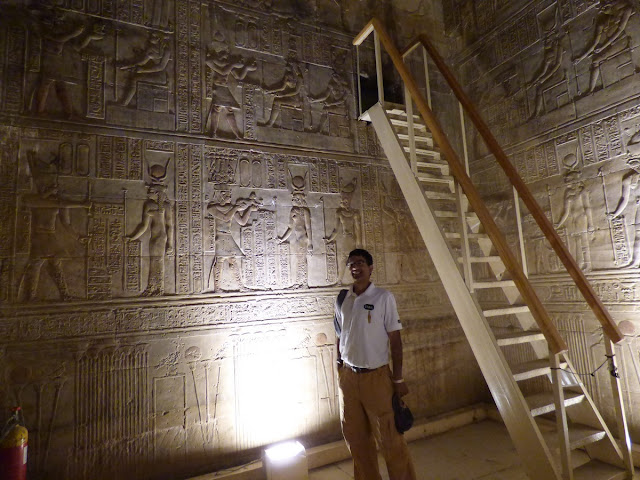



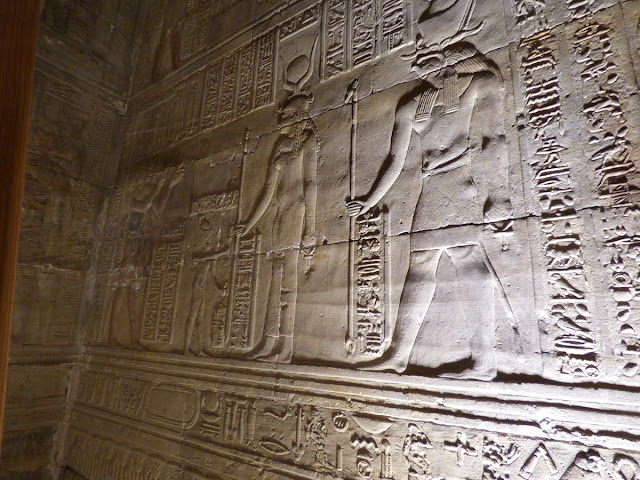



























































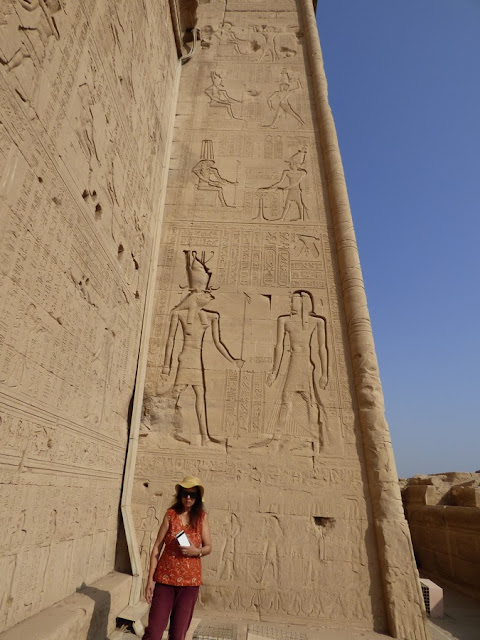




















No comments:
Post a Comment